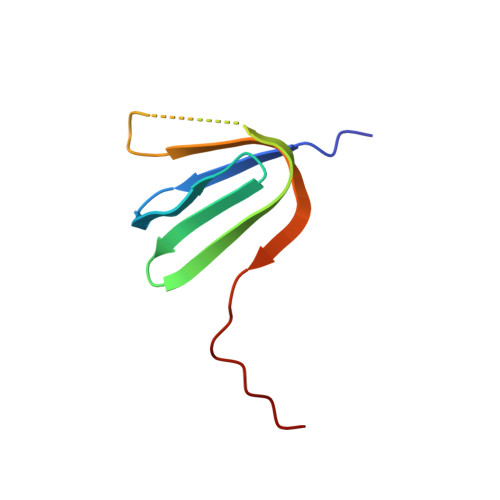Combining NMR and EPR methods for homodimer protein structure determination.
Yang, Y., Ramelot, T.A., McCarrick, R.M., Ni, S., Feldmann, E.A., Cort, J.R., Wang, H., Ciccosanti, C., Jiang, M., Janjua, H., Acton, T.B., Xiao, R., Everett, J.K., Montelione, G.T., Kennedy, M.A.(2010) J Am Chem Soc 132: 11910-11913
- PubMed: 20698532
- DOI: https://doi.org/10.1021/ja105080h
- Primary Citation of Related Structures:
2KS0, 2KYI - PubMed Abstract:
There is a general need to develop more powerful and more robust methods for structural characterization of homodimers, homo-oligomers, and multiprotein complexes using solution-state NMR methods. In recent years, there has been increasing emphasis on integrating distinct and complementary methodologies for structure determination of multiprotein complexes. One approach not yet widely used is to obtain intermediate and long-range distance constraints from paramagnetic relaxation enhancements (PRE) and electron paramagnetic resonance (EPR)-based techniques such as double electron electron resonance (DEER), which, when used together, can provide supplemental distance constraints spanning to 10-70 A. In this Communication, we describe integration of PRE and DEER data with conventional solution-state nuclear magnetic resonance (NMR) methods for structure determination of Dsy0195, a homodimer (62 amino acids per monomer) from Desulfitobacterium hafniense. Our results indicate that combination of conventional NMR restraints with only one or a few DEER distance constraints and a small number of PRE constraints is sufficient for the automatic NMR-based structure determination program CYANA to build a network of interchain nuclear Overhauser effect constraints that can be used to accurately define both the homodimer interface and the global homodimer structure. The use of DEER distances as a source of supplemental constraints as described here has virtually no upper molecular weight limit, and utilization of the PRE constraints is limited only by the ability to make accurate assignments of the protein amide proton and nitrogen chemical shifts.
Organizational Affiliation:
Department of Chemistry and Biochemistry, Miami University, Oxford, Ohio 45056, USA.














